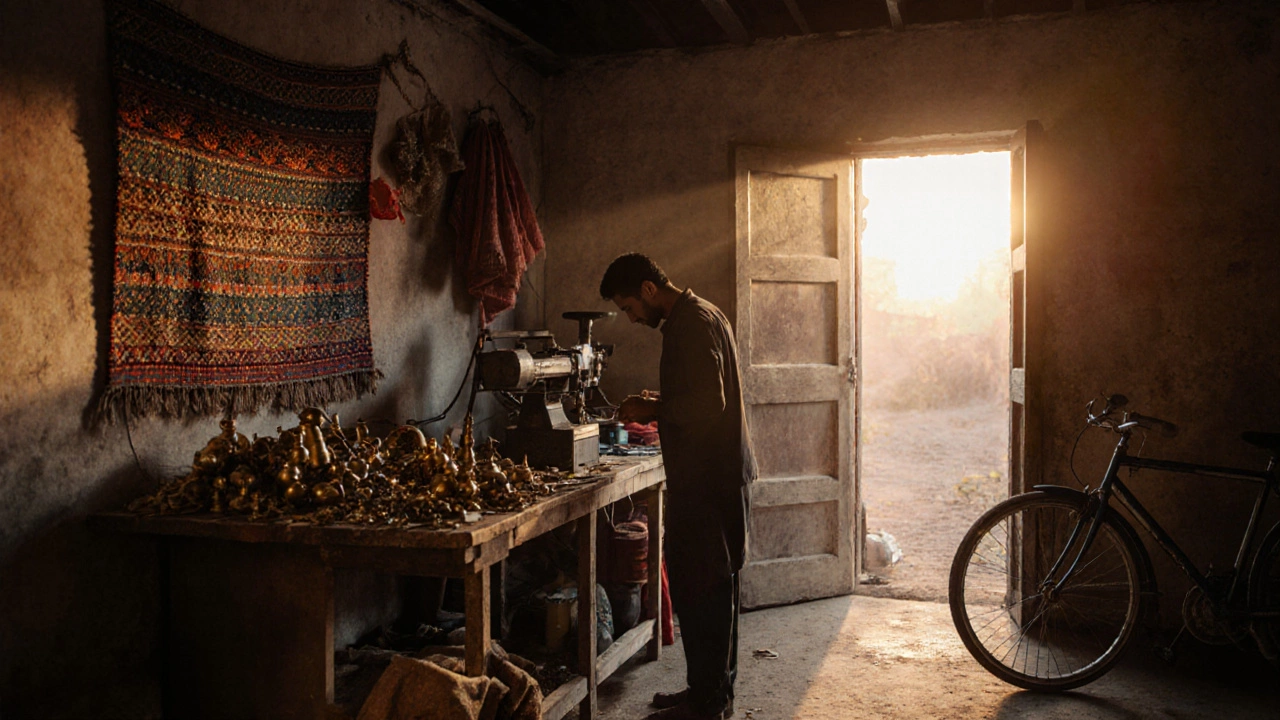- What Is the 15-Year Car Rule in India? Everything You Need to Know Oct 30, 2025
- What is the biggest plastic producer company in the world? Oct 28, 2025
- What Are the Advantages of Small Scale Industries? Nov 20, 2025
- Steel Production: Which US City Takes the Crown? Jun 12, 2025
- What Business Is Free to Start? Smart Ideas for Manufacturing Startups Apr 29, 2025
Small Scale Manufacturing – Practical Tips, Ideas & Costs
If you’re thinking about turning a workshop into a money‑making machine, you’ve come to the right place. Small scale manufacturing isn’t just for hobbyists; it can be a solid, steady income stream when you get the basics right. Below you’ll find simple steps, real‑world cost numbers, and ideas that actually sell today.
Top Business Ideas You Can Start Today
First, pick a product that fits your skills and the market demand. Some ideas that are humming in 2025 include eco‑friendly packaging, custom 3D‑printed accessories, and low‑cost metal parts for local farms. These ideas need modest equipment and can be scaled up as orders grow. If you love crafting, handmade soaps or wooden décor are also strong bets because they command a premium for quality.
When you choose, ask yourself three quick questions: Do I have the know‑how or can I learn fast? Is there a local or niche market willing to pay? Can I source raw material at a reasonable price? Answering yes to all three means you’re past the idea stage and ready for a plan.
How Much Money Do You Really Need?
Money worries are the biggest roadblock for new manufacturers. A typical starter budget in India ranges from ₹2 lakh to ₹10 lakh, depending on the product complexity. Break it down into three buckets: equipment, raw material, and working capital. For a simple plastic molding unit, you might spend ₹3 lakh on a small injection‑molding machine, ₹1 lakh on raw pellets, and keep another ₹2 lakh for rent and utilities until the first cash‑in comes.
Don’t forget hidden costs – electricity spikes, maintenance, and a modest marketing push on social media. Many entrepreneurs forget these and run out of cash fast. A good rule is to add a 20% buffer on top of your calculated expenses.
Below is a quick snapshot of common cost categories:
- Equipment: ₹2‑₹5 lakh (depends on automation level)
- Raw material: ₹0.5‑₹2 lakh (first batch)
- Space & utilities: ₹0.5‑₹1 lakh (monthly)
- Marketing: ₹0.2‑₹0.5 lakh (initial)
- Buffer: 20% of total
With this layout you can see exactly where each rupee goes, making it easier to get a loan or pitch an investor.
Aside from money, keep an eye on cash flow. Get paid quickly by asking for a small advance or using simple invoicing tools. A steady cash flow stops the panic that drives many small manufacturers out of business.
Finally, test your product before you scale. Run a pilot batch, gather feedback, tweak the design, then ramp up production. This cycle keeps waste low and profit margins high – the exact formula successful small scale players swear by.
Ready to start? Grab a notebook, jot down your idea, budget the numbers above, and take the first step. The market is hungry for niche, quality products. With the right plan, your small scale manufacturing venture can become a reliable source of income and growth.
What Are the Advantages of Small Scale Industries?
- Aarav Sekhar
- Nov 20, 2025
Small scale industries offer lower costs, faster adaptation, local job creation, and environmental benefits. They thrive on customization, resilience, and direct customer relationships-making them vital to modern economies.
Why Small Scale Businesses Fail: Top Reasons Nobody Tells You
- Aarav Sekhar
- Jun 23, 2025
Most small scale manufacturing businesses struggle not because of bad products, but hidden problems like poor money management, badly planned demand, and weak leadership. This article dives into why these businesses shut down and what small owners can do differently. You'll learn from real-world mistakes and get tips that truly work. If you're thinking about starting or saving a small manufacturing business, you want to read this. Find out how to keep your dream running in today's tough market.
How Much Do I Need to Start a Small Scale Manufacturing Business?
- Aarav Sekhar
- Jun 4, 2025
If you're thinking about starting a small manufacturing business, figuring out the real costs is usually the toughest part. This guide breaks down where your money will actually go, what expenses beginners forget, and practical tips to start lean. We’ll look at examples and share cost-saving moves based on today’s market, so you know what to expect and what to watch out for. It’s all about getting clear numbers, skipping guesswork, and helping you decide if you’re really ready to jump in.
Most Profitable Small Scale Manufacturing Business Ideas
- Aarav Sekhar
- Apr 6, 2025
Discover the most profitable small scale manufacturing business ideas that can thrive in today's competitive market. This article explores viable options, offering tips and insights into starting a successful small-scale manufacturing venture. With practical advice on choosing the right product and understanding market demands, it's a must-read for aspiring entrepreneurs. Learn how to turn your passion into a lucrative business.
How to Start a Small Scale Industry Successfully
- Aarav Sekhar
- Mar 31, 2025
Starting a small scale industry can be a game-changer in today’s market. This guide explores actionable steps and valuable insights for setting up your own manufacturing venture. From understanding your niche market to handling finances effectively, we'll cover practical tips that can help transition from the planning phase to operational success. Real-world examples and common pitfalls are also discussed to equip entrepreneurs with essential tools.
Most Popular Small Business in Manufacturing: What's Leading the Pack?
- Aarav Sekhar
- Mar 16, 2025
Exploring the booming world of small-scale manufacturing, this article delves into the most popular types of small businesses within the sector as of 2025. Discover what makes these ventures appealing, backed by interesting facts and practical tips for potential entrepreneurs. Learn about success stories and key trends driving growth in small-scale manufacturing.
Cheapest Businesses to Start in Small-Scale Manufacturing
- Aarav Sekhar
- Mar 9, 2025
Starting a business doesn't have to break the bank, especially in small-scale manufacturing. If you're thinking about diving into this field, it's crucial to understand your options and what makes them affordable. This article explores the most economical manufacturing ideas, offering tips and insights that can help you get started with minimal costs. Whether you're passionate about handmade crafts or eager to enter a niche market, there are plenty of opportunities waiting for you. Learn how to leverage your resources and creativity to launch a cost-effective manufacturing venture.
Booming Small-Scale Manufacturing Businesses in 2024
- Aarav Sekhar
- Feb 17, 2025
Small-scale manufacturing is set to see significant growth in 2024, driven by demand for niche products, shifts in consumer preferences, and technological advancements. From eco-friendly packaging to custom 3D-printed goods, these industries offer entrepreneurs promising opportunities to explore. With lower barriers to entry and the ability to cater to specialized markets, small manufacturers can thrive by focusing on quality and agility. Entrepreneurs should stay informed about emerging trends to capture these opportunities effectively.
Understanding the Dynamics of Small Scale Production Processes
- Aarav Sekhar
- Jan 7, 2025
Small scale production refers to the creation of goods on a smaller scale using limited resources, typically for local or niche markets. Often characterized by lower capital investment and flexible operations, it allows businesses to respond swiftly to market demands. A central aspect of small scale production is the emphasis on craftsmanship, quality, and sustainability instead of mass-produced goods. This production style can reduce waste, utilize local resources, and promote community development. Understanding its dynamics can be crucial for businesses seeking a sustainable and adaptable manufacturing approach.
Understanding Micro Small Scale Industry: Key Insights for Aspiring Entrepreneurs
- Aarav Sekhar
- Jan 7, 2025
Micro small scale industries are the backbone of many economies, providing employment and fostering innovation. These enterprises are characterized by low investment and typically focus on specialized products or services. Understanding the unique challenges and opportunities they face can provide valuable insights for aspiring entrepreneurs. Key topics include funding, marketing strategies, and regulatory considerations.









